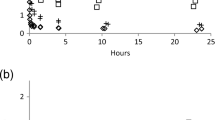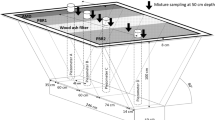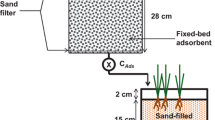Abstract
The effectiveness of compost, peat-calcite, and wood ash to remove Ni from a circum-neutral-contaminated mine water was tested in continuous flow experiments. Materials were compared in 4.8-L columns at hydraulic residence times (HRT) of ∼ 16.5 h over the course of 2.5–4 months. During this period, all columns successfully treated over 400 L of synthetic contaminated neutral drainage (4.05 mg/L Ni), mainly through sorption processes. Mid-column results (HRT ∼ 9 h) indicated that wood ash was the most effective material for Ni removal, and chemical extractions revealed that retained Ni was less mobile in this spent material. The pH-increasing properties of wood ash played a major role in this material’s performance, but a pH correction would be required in the initial stages of full-scale treatment to maintain the effluent within regulatory limits (6–9.5). Scaled to full-sized, mid-column results indicated that treatment cell sizes, designed for the 1-year treatment of a high discharge (10 m3/h)–contaminated effluent (4.05 mg/L Ni), would be the smallest with wood ash (< 500 m3), followed by compost (600 ± 140 m3) and peat-calcite (720 ± 50 m3).





Similar content being viewed by others
Data availability
All data generated or analyzed during this study are included in this published article and its supplementary information file.
References
Ali A, Gupta VK (2006) Advances in water treatment by adsorption technology. Nature Protocols 1:2661–2667
APHA (1998) Standard methods for the examination of water and wastewater, 20th edn. American Public Health Association, Washington, D.C.
APHA (2005) Standard methods for the examination of water and wastewater, 21st edn. American Public Health Association, Washington, D.C.
ASTM (2000) 2434–68 —standard test method for permeability of granular soils (constant head). Annual book of ASTM standards. West Conshohocken, PA, In
ASTM (2014) D854–14, − standard test method for specific gravity of soil solids by water pycnometer. Annual book of ASTM standards. West Conshohocken, PA, In
Bogart SJ, Woodman S, Steinkey D, Meays C, Pyle GC (2016) Rapid changes in water hardness and alkalinity: Calcite formation is lethal to Daphnia magna. Science of the Total Environment 559:182–191. https://doi.org/10.1016/j.scitotenv.2016.03.137
Brunauer S, Emmett PH, Teller E (1938) Adsorption of gases in multimolecular layers. Journal of the American Chemical Society Soc 60:309–319
Calugaru IL, Neculita CM, Genty T, Bussiere B, Potvin R (2017) Removal of Ni and Zn in contaminated neutral drainage by raw and modified wood ash. Journal of Environmental Science and Health, Part A 52:117–126. https://doi.org/10.1080/10934529.2016.1237120
Calugaru IL, Neculita CM, Genty T, Zagury GJ (2018) Metals and metalloids treatment in contaminated neutral effluents using modified materials. Journal of Environmental Management 212:142–159. https://doi.org/10.1016/j.jenvman.2018.02.002
CEAEQ (2013) Détermination du carbone et du soufre: méthode par combustion et dosage par spectrophotométrie infrarouge. Méthode MA310-CS 10 http://wwwceaeqgouvqcca/methodes/pdf/MA310CS10pdf Accessed (2019-06-18 2019)
CEAEQ (2014) Détermination du carbone organique total dans les solides: dosage par titrage, Méthode MA. 405 - C 1.1. http://www.ceaeq.gouv.qc.ca/methodes/pdf/MA310CS10.pdf. 2018
CEAEQ (2019) Détermination de l'alcalinité et de l'acidité: méthode titrimétrique automatisée. Méthode MA 315 - Alc-Aci 10 http://wwwceaeqgouvqcca/methodes/pdf/MA315AlcAc10pdf. Accessed (2019-06-18 2019)
Chapman HD (1965) Cation exchange capacity. In: Black CA (ed) Methods of soil analysis. American Society of Agronomy, Madison, pp 891–901
Chapuis RP, Baass K, Davenne L (1989) Granular soils in rigid-wall permeameters - method for determining the degree of saturation. Canadian Geotechnical Journal 26:71–79. https://doi.org/10.1139/t89-008
Claveau-Mallet D, Wallace S, Comeau Y (2012) Model of phosphorus precipitation and crystal formation in electric arc furnace steel slag filters. Environmental Science and Technology 46:1465–1470. https://doi.org/10.1021/es2024884
Courcelles B, Modaressi-Farahmand-Razavi A, Gouvenot D, Esnault-Filet A (2011) Influence of precipitates on hydraulic performance of permeable reactive barrier filters. International Journal of Geomechanics 11:142–151. https://doi.org/10.1061/(asce)gm.1943-5622.0000098
de Repentigny C, Courcelles B, Zagury GJ (2018) Spent MgO-carbon refractory bricks as a material for permeable reactive barriers to treat a nickel- and cobalt-contaminated groundwater. Environmental Science and Pollution Research 25:23205–23214. https://doi.org/10.1007/s11356-018-2414-3
Demeyer A, Nkana JCV, Verloo MG (2001) Characteristics of wood ash and influence on soil properties and nutrient uptake: an overview. Bioresource Technology 77:287–295. https://doi.org/10.1016/s0960-8524(00)00043-2
Ford DC, Williams PW (2007) Karst geomorphology and hydrology. Unwin Hyman, London
Genty T, Bussiere B, Benzaazoua M, Zagury GJ (2012) Capacity of wood ash filters to remove iron from acid mine drainage: assessment of retention mechanism. Mine Water and the Environment 31:273–286. https://doi.org/10.1007/s10230-012-0199-z
Gosselin M, Zagury GJ (2020) Metal(loid)s inhalation bioaccessibility and oxidative potential of particulate matter from chromated copper arsenate (CCA)-contaminated soils. Chemosphere 238:124557. https://doi.org/10.1016/j.chemosphere.2019.124557
Gustafsson JP (2019) Visual MINTEQ ver. 31 https://vminteqlwrkthse/ Accessed 2019-02-01 2019
Hengen TJ, Squillace MK, O’Sullivan AD, Stone JJ (2014) Life cycle assessment analysis of active and passive acid mine drainage treatment technologies. Resources, Conservation and Recycling 86:160–167. https://doi.org/10.1016/j.resconrec.2014.01.003
Hull SL, Oty UV, Mayes WM (2014) Rapid recovery of benthic invertebrates downstream of hyperalkaline steel slag discharges. Hydrobiologia 736:83–97. https://doi.org/10.1007/s10750-014-1894-5
Inglezakis VJ, Fyrillas MM, Park J (2019) Variable diffusivity homogeneous surface diffusion model and analysis of merits and fallacies of simplified adsorption kinetics equations. Journal of Hazardous Materials 367:224–245. https://doi.org/10.1016/j.jhazmat.2018.12.023
Komonweeraket K, Cetin B, Benson CH, Aydilek AH, Edil TB (2015) Leaching characteristics of toxic constituents from coal fly ash mixed soils under the influence of pH. Waste Management 38:174–184. https://doi.org/10.1016/j.wasman.2014.11.018
Koryak M, Stafford LJ, Reilly RJ, Magnuson MP (2002) Impacts of steel mill slag leachate on the water quality of a small Pennsylvania stream. Journal of Freshwater Ecology 17:461–465. https://doi.org/10.1080/02705060.2002.9663921
Malamis S, Katsou E (2013) A review on zinc and nickel adsorption on natural and modified zeolite, bentonite and vermiculite: examination of process parameters, kinetics and isotherms. Journal of Hazardous Materials 252-253:428–461
Neculita CM, Zagury GJ, Bussière B (2007) Passive treatment of acid mine drainage in bioreactors using sulfate-reducing bacteria: Critical Review and Research Needs. Journal of Environmental Quality 36:1–16. https://doi.org/10.2134/jeq2006.006
Neculita CM, Zagury GJ, Bussière B (2008) Effectiveness of sulfate-reducing passive bioreactors for treating highly contaminated acid mine drainage: II. Metal removal mechanisms and potential mobility. Applied Geochemistry 23:3545–3560. https://doi.org/10.1016/j.apgeochem.2008.08.014
Nordstrom DK, Blowes DW, Ptacek CJ (2015) Hydrogeochemistry and microbiology of mine drainage: an update. Applied Geochemistry 57:3–16. https://doi.org/10.1016/j.apgeochem.2015.02.008
Ohno T (1992) Neutralization of soil acidity and release of phosphorus and potassium by wood ash. Journal of Environmental Quality 21:433–438. https://doi.org/10.2134/jeq1992.00472425002100030022x
Peregoedova A (2013) Étude expérimentale des propriétés hydrogéologiques des roches stériles à une échelle intermédiaire de laboratoire. M.Sc.A. École Polytechnique, Montréal
Pinto PX, Al-Abed SR (2017) Assessing metal mobilization from industrially lead-contaminated soils located at an urban site. Applied Geochemistry 83:31–40. https://doi.org/10.1016/j.apgeochem.2017.01.025
Rees F, Simonnot MO, Morel JL (2014) Short-term effects of biochar on soil heavy metal mobility are controlled by intra-particle diffusion and soil pH increase. European Journal of Soil Science 65:149–161. https://doi.org/10.1111/ejss.12107
Richard D, Sundby B, Mucci A (2013) Kinetics of manganese adsorption, desorption, and oxidation in coastal marine sediments. Limnology and Oceanography 58:987–996. https://doi.org/10.4319/lo.2013.58.3.0987
Richard D, Mucci A, Neculita CM, Zagury GJ (2020a) Comparison of organic materials for the passive treatment of synthetic neutral mine drainage contaminated by nickel: adsorption and desorption kinetics and isotherms. Water Air and Soil Pollution. https://doi.org/10.1007/s11270-020-04917-z
Richard D, Mucci A, Neculita CM, Zagury GJ (2020b) Comparison of organic materials for the passive treatment of synthetic neutral mine drainage contaminated by nickel: Short- and medium-term batch experiments. Appl Geochem 123:104772. https://doi.org/10.1016/j.apgeochem.2020.104772
Riley AL, Mayes WM (2015) Long-term evolution of highly alkaline steel slag drainage waters. Environmental Monitoring and Assessment 187:463. https://doi.org/10.1007/s10661-015-4693-1
Sauty JP (1980) Analysis of hydrodispersive transfer in aquifers. Water Resour Res 16:145–158
Skousen J, Zipper CE, Rose A, Ziemkiewicz PF, Nairn R, McDonald LM, Kleinmann RL (2017) Review of passive systems for acid mine drainage treatment. Mine Water and the Environment 36:133–153
Stokes P (1988) Nickel in aquatic systems. In: Sigel H, Sigel A (eds) Metal ions in biological systems: nickel and its role in biology, vol 23. Marcel Dekker, New York, pp 31–46
Tessier A, Campbell PGC, Bisson M (1979) Sequential extraction procedure for the speciation of particulate trace metals. Analytical Chemistry 51:844–851
Tran HN, You S-J, Hosseini-Bandegharaei A, Chao H-P (2017) Mistakes and inconsistencies regarding adsorption of contaminants from aqueous solutions: a critical review. Water Research 120:88–116. https://doi.org/10.1016/j.watres.2017.04.014
Trumm D, Pope J (2015) Passive treatment of neutral mine drainage at a metal mine in New Zealand using an oxidizing system and slag leaching bed. Mine Water and the Environment 34:430–441. https://doi.org/10.1007/s10230-015-0355-3
Ulery AL, Graham RC, Amrhein C (1993) Wood-ash composition and soil-ph following intense burning. Soil Science 156:358–364. https://doi.org/10.1097/00010694-199311000-00008
Warrender R, Pearce NJG, Perkins WT, Florence KM, Brown AR, Sapsford DJ, Bowell RJ, Dey M (2011) Field trials of low-cost reactive media for the passive treatment of circum-neutral metal mine drainage in mid-Wales, UK. Mine Water and the Environment 30:82–89. https://doi.org/10.1007/s10230-011-0150-8
Zagury GJ, Colombano SM, Narasiah KS, Ballivy G (1997) Neutralization of acid mine tailings by addition of alkaline sludges from pulp and paper industry. Environmental Technology 18:959–973. https://doi.org/10.1080/09593331808616616
Acknowledgments
DR wishes to acknowledge support from the “Fonds de recherche Nature et technologies” (FQRNT) graduate scholarship program and from the “Fondation et alumni de Polytechnique Montréal” (Bourse Banque de Montréal).
Funding
This study was funded by the NSERC (Natural Sciences and Engineering Research Council of Canada), grant no. 469489-14, and the industrial partners of the RIME UQAT Polytechnique Montreal, including Agnico Eagle, Mine Canadian Malartic, Iamgold, Raglan Mine Glencore, and Rio Tinto.
Author information
Authors and Affiliations
Contributions
DR participated in the conceptualization of the project and performed the experiments. She wrote the methodology, analyzed the data, and wrote the original draft. DR also reviewed and edited the manuscript. CMN participated in project conceptualization and data interpretation. CMN also reviewed and edited the manuscript. GJZ conceptualized and supervised the project, participated in the development of the methodology, analyzed the data, co-wrote, reviewed, and edited the final manuscript. All authors read and approved the final manuscript.
Corresponding author
Ethics declarations
Ethics approval and consent to participate
Not applicable.
Consent for publication
Not applicable.
Competing interests
The authors declare that they have no competing interests.
Additional information
Responsible editor: Tito Roberto Cadaval Jr
Publisher’s note
Springer Nature remains neutral with regard to jurisdictional claims in published maps and institutional affiliations.
Supplementary information
ESM 1
(DOCX 343 kb)
Rights and permissions
About this article
Cite this article
Richard, D., Neculita, C.M. & Zagury, G.J. Removal of nickel from neutral mine drainage using peat-calcite, compost, and wood ash in column reactors. Environ Sci Pollut Res 28, 14854–14866 (2021). https://doi.org/10.1007/s11356-020-11623-0
Received:
Accepted:
Published:
Issue Date:
DOI: https://doi.org/10.1007/s11356-020-11623-0




